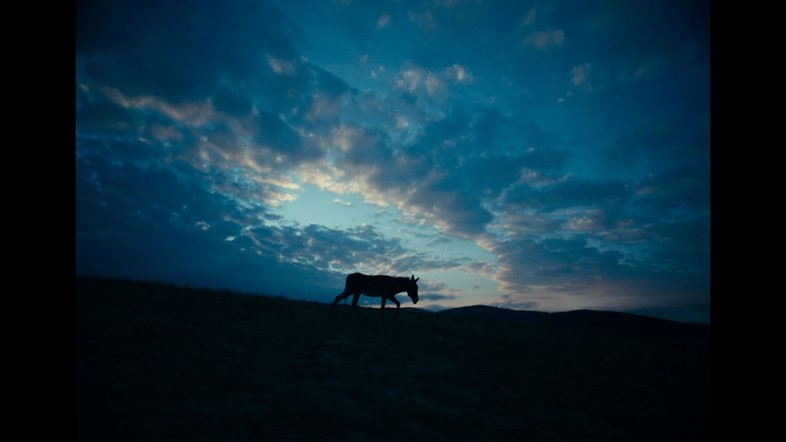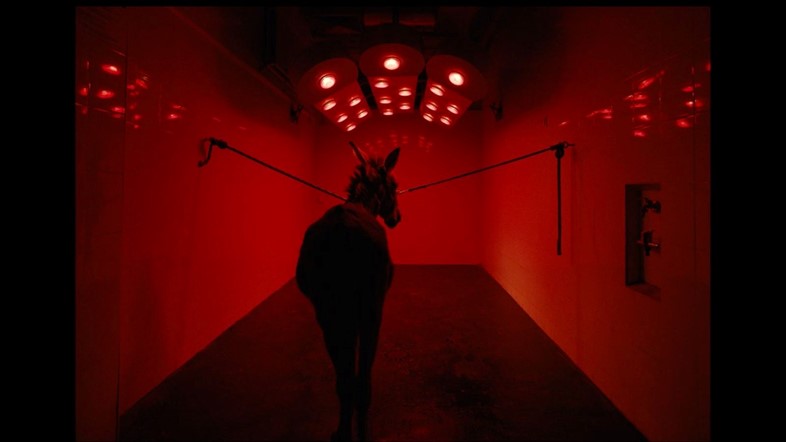Director Jerzy Skolimowski and co-producer Ewa Piaskowska unpack the thinking behind their new film EO – “the main message is about humans’ not treating animals properly,” they say
Jerzy Skolimowski has made his most electric film since the 80s in his 80s. Directed by the 84-year-old Polish auteur with a rock ‘n’ roll punk attitude, EO follows a donkey on a solo, sparse odyssey as he escapes scrapes, lands in sci-fi scenarios, and proves the medium has been wasting its time with human protagonists. Featuring football hooligans, robot creatures, and high-end fashion shoots, Skolimowski’s eighteenth feature is several movies rolled into one, all united by the power of the donkey.
Our introduction to EO (phonetically named after its bray) is in a circus where the four-legged individual is personally fed carrots by a young female dancer. When well-meaning animal activists shut down the arena, EO ironically loses his life of luxury: he traverses cold, threatening landscapes in search of food and shelter, sometimes like it’s a live-action version of The Lion King, only to find toxic, violent men populating the non-circus world.
Perhaps an easier way to describe EO – a nominee at the 2023 Oscars for Best International Feature – is to compare it to Robert Bresson’s Au Hasard Balthazar, an austere, black-and-white drama from 1966 in which a donkey is passed between a succession of cruel owners. However, EO, colourfully shot in a boxy 4:3 aspect ratio and boasting a raucous electronic score, reverses several of Bresson’s creative decisions, at one point flooding the screen with foreboding shades of red to signify a dream sequence from the donkey’s POV.
In fact, in a hotel during the London Film Festival, when I refer to EO as a remake, Skolimowski insists, “It’s not close to a remake. It’s not even ‘inspired’. It’s a homage, but I purposefully did everything possible to make it different,” he says. “Bresson’s film was an intellectual exercise,” clarifies Ewa Piaskowska, 49, a co-producer and co-writer on EO and other Skolimowski movies. “This is an emotional exercise.”
Skolimowski and Piaskowska, who are also husband and wife, tell me that they live with pets in a forest in northern Poland, surrounded by wild animals and away from asphalt roads. EO, then, is their ode to non-human creatures – Piaskowska jokes that they’re “Greenpeace enthusiasts”. Still, I wonder: were they consciously or subconsciously writing about themselves in EO? “Maybe unwittingly,” says Skolimowski. “It wasn’t meant to be an autobiography. But the donkey is an outsider and kind of an immigrant. There are elements in common between the main character and myself.”

A poet and boxer in his youth, Skolimowski went on to direct wild, unpredictable genre movies about outcasts – basically donkeys in human form. His most celebrated include Deep End (a teen boy loses his mind through unfulfilled sexual urges), The Shout (a scream is so loud, it kills those who hear it), and Moonlighting (a political satire about Poland’s Solidarity protests starring Jeremy Irons).
However, it’s EO that stands out in Skolimowski’s filmography as an acting masterclass. The central donkey – played by six donkeys with separate skills – is one of the most captivating onscreen characters since the donkey in Au Hasard Balthazar. Like a living, breathing Rorschach test, EO reflects whatever complex emotions are projected by the viewer onto its blank stare. “The donkey’s eyes are melancholic and full of ambiguity,” says Skolimowski. “I wouldn’t call it sadness.”
Often, the viewer perceives the world through EO’s eyes. After some failed experiments with GoPro and different lenses, Skolimowski turned to an editorial pattern: a master shot, a close-up of the donkey’s eyes, and then a slow-moving camera to signify the perspective of an animal standing still. “It’s exactly the same set but the POV looks different from the master shot,” Skolimowski explains. “It couldn’t be described in words. Reality looks different in a donkey’s eyes.” Piaskowska continues: “the film is made for humans, not donkeys. If you were making a film for donkeys, it’d be important to have the internal life of donkeys objectively shown. But we want to move a human being. That’s why we use a human perspective to delve into an animal’s mind.”

After EO receives a violent thrashing, the film cuts to a seemingly unrelated sequence: a four-legged robot roaminga field with elegance to its animatronic limbs. I initially assumed it was a dream, perhaps EO fantasising about possessing superhero strength. Then I heard Film Comment’s podcast theorise that EO is, deep down, a robot beneath its grey flesh.
Skolimowski immediately shoots down all these ideas. “The robot is a warning to people,” Skolimowski says. “What’s next? If we don’t take care of real, living animals, then we’ll be left with robots pretending to be animals. Don’t we prefer the real expression of the eyes, the grace of animals who move?” The director animatedly imitates a donkey for me. “It’s a warning!” But, I note, the robot donkey looks like a miraculous piece of technology and, if you live in a city, probably a fun toy. Skolimowski doesn’t hide his disappointment. “Maybe it’s generational. Now, young people may like to have robots. But I prefer them to be living. I enjoy the beauty of nature.”
Towards the end of EO, there’s a surprise, plate-smashing cameo from Isabelle Huppert. Well, it’s surprising in that it doesn’t make much sense within the story. I ask if EO was ever considered a parable for working within the film industry, hence the Huppert casting? “One could be suspicious about that,” says Skolimowski. “But no. The main message is about humans’ attitude towards animals. We’re animal lovers. We step out every day into a wild forest to appreciate nature in its real form without human intervention. We wanted that message to reach the widest possible audience, and needed a name so it wouldn’t be treated like some little film from some Eastern country in an unknown language. And Isabelle Huppert has that calibre.”

However, at Cannes, upon winning the Jury Prize, Skolimowski thanked his six donkeys by name in his acceptance speech. One was discovered on Facebook, the other five were first-time performers. “We always had veterinary assistance,” says Skolimowski. “We checked them at the start and end of every day. The conditions guaranteed no harm.” “They’re the stars of the film,” adds Piaskowska. “The animals were the real stars.” Even more than Isabelle Huppert? “Much more.”
As for EO’s utopian life in a circus being undone by animal rights activists, Skolimowski knows it’s a contradiction. “Humans tends to use animals,” he sighs. “They treat them like objects, not living creatures.” “Some people do,” says Piaskowska. “Not all people.” “I would say most people,” says Skolimowski. “Maybe in cities,” says Piaskowska. “Not people with cats and dogs in the house.” “Unfortunately, in villages, they have dogs on chains and things like this,” says Skolimowski. “Generally, human beings are not treating animals in the proper way, and that’s the message of this film. This film was made out of love for animals.”
EO will be released in UK cinemas from February 3. Outsiders and Exiles: The Films of Jerzy Skolimowski runs at BFI Southbank in London from 27 March – 30 April 2023.
